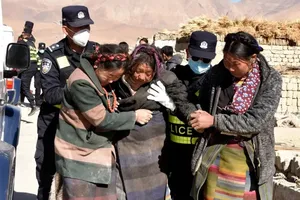Chilean rescuers begin Monday the months-long task of drilling a shaft to rescue 33 miners trapped deep underground for 25 days, as officials push for an accelerated rescue plan.
Another plan "has already been designed," Health Minister Jaime Manalich said, adding that details would be released soon.
Under the current plans, an Australian-made hydraulic bore will drill a hole 66 centimeters (26 inches) wide to pull the miners out one at a time from the hot and damp shelter where they are huddled underground.
"The shaft we're drilling to the shelter will go down 702 meters (2,303 feet) in a straight line" to the trapped miners, the engineer in charge of the rescue operation, Andre Sougarret, told AFP on Saturday.

Sougarret said the drilling operation was expected to last three to four months, in line with previous estimates.
The hydraulic bore drills at a maximum rate of 20 meters (66 feet) per day. The initial narrow shaft it will dig will have to be doubled in diameter to allow a man to pass through, Sougarret explained.
Officials are also considering drilling where the main entrance ramp to the San Jose gold and silver mine collapsed on August 5, though some engineers fear the site remains unstable.
A third option being tabled suggests broadening an already existing shaft some 12 centimeters (five inches) in diameter, about 300 meters (985 feet) from the emergency shelter where the miners are confined.
According to Geotec, the company owning the drilling equipment, expanding that shaft could free the men in about 60 days, two whole months ahead of early estimates.
Geotec manager Walter Herrera said government experts were studying this proposal. But Mining Minister Laurence Golborne earlier rejected reports of a possible rescue within the next month.
"We have reviewed 10 different options," he told Radio Cooperativa. "Up to now there is no alternative... that would allow us to get them out in 30 days."
Golborne said that while the Australian-made bore went to work, engineers would also be widening a third existing access shaft to the miners' shelter from 10.2 centimeters to 30.5 centimeters (four-12 inches) so bigger objects can be sent down to them.
On Sunday, the miners spoke for the first time with their loved ones Sunday, reassuring each other in brief but moving conversations by radio-telephone after 24 days underground.
"To hear his voice was a balm to my heart," said Jessica Chille after speaking to her husband, Dario Segovia.
Limited to one minute per miner, the wives, mothers and fathers lined up for their first person-to-person conversations since a cave-in August 5 blocked the miners' exit from the San Jose mine.
"I didn't break down until I told him: ciao, my little boy, we will see each other," said Alicia Campos, after speaking to her son Daniel Herrero.
"His voice is the same. He's not good but not so bad either," she said.
The conversations were morale boosters for miners and their families who must wait three to four months to be rescued.
Until now they only have been able to exchange written messages and video images relayed through narrow probe holes.
Out of sight of family and media, engineers finished assembling a powerful Strata 950 drill to bore through more than 700 meters (2,300 feet) of rock and earth to reach the miners.
A delay in the arrival of a missing part set back the schedule by several hours but "drilling will begin on Monday," the mining minister told reporters.
Pope Benedict XVI on Sunday remembered the miners "with special affection" in his angelus prayer at the pontiff's summer residence in Castel Gandolfo.
He offered them "assurances of my spiritual proximity and my continual prayers, that they maintain serenity during the wait for a happy conclusion to the work undertaken to save them."
























